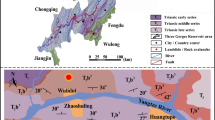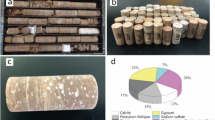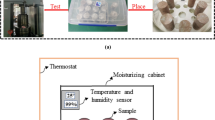Abstract
Recent research has paid little attention to weakening of discontinuities with different joint wall material (DDJM) induced by wetting and drying cycles. Experimental investigations were conducted to examine the effects of wetting–drying cycles on weakening of three typical types of natural planar DDJM collected from a sliding-prone formation in the Three Gorges reservoir region of China. Deterioration of the corresponding four types of discontinuities with identical joint wall material (DIJM) were also been studied for comparison. The weakening laws of DDJM were revealed from macro- and microperspectives by testing on mineral compositions, microstructures and water absorption rate of joint walls as well as shear strength of discontinuities. The results indicate that the repeated wetting–drying cycles lead to obvious changes in microstructure and increases of macro water absorption rate for the studied joint walls with the changing degree closely related to their clay mineral contents; the peak shear strengths of DDJM gradually decreases with the wetting and drying cycles for a certain normal stress with the weakening rate between that of the DIJM with two joint wall materials of the DDJM, while closer to that of DIJM with the weak half materials of the DDJM; significant correlations have been found between the variation coefficient of rock microstructure of joint walls and the macrodeterioration coefficient of DDJM; the changing rates of multi-scale parameters before and after six wetting–drying cycles vary obviously, indicating the weakening is slowed down after six wetting–drying cycles for the studied discontinuities.
Highlights
-
Effects of wetting-drying cycles on weakening discontinuities with different joint wall material were studied.
-
Deterioration of the discontinuities with identical joint wall material were also been investigated for comparison.
-
The weakening laws were revealed from macro and micro perspectives.
-
Significant correlations have been found between the variation coefficient of microstructure of joint walls and the macro deterioration coefficient.
-
The results could provide a basis to better understand the stability evolution of rock slopes with soft and hard rock interbedded.












Similar content being viewed by others
References
Alonso EE, Zandarín MT, Olivella S (2013) Joints in unsaturated rocks: thermo-hydro-mechanical formulation and constitutive behaviour. J Rock Mech Geotech Eng 5(3):200–213. https://doi.org/10.1016/j.jrmge.2013.05.004
ASTM Standard C97(1987) Standard test methods for absorption and bulk specific gravity of dimension stone. ASTM International, West Conshohocken. https://doi.org/10.1520/C0097_C0097M-09
Criss RE, Yao WM, Li CD, Tang HM (2020) A predictive, two-parameter model for the movement of reservoir landslides. J Earth Sci 31(6):1051–1057. https://doi.org/10.1007/s12583-020-1331-9
Ding XL, Liu J, Liu XZ (2000) Experimental study on creep behaviors of hard structural plane in TGP’s permanent lock regions. J Yangtze River Sci Res Inst 17(4):30–33. https://doi.org/10.3969/j.issn.1001-5485.2000.04.009
Fang K, Tang HM, Su XX, Shang WT, Jia SL (2020) Geometry and maximum width of a stable slope considering the arching effect. J Earth Sci 31(6):1087–1096. https://doi.org/10.1007/s12583-020-1052-0
Fang K, Wu Q, Wang J, Tan FL (2014) Research on shear characteristics and the evolution mechanism of bedding planes between two different rock types based on particle flow code. J Yangtze River Sci Res Inst 31(11):31–37. https://doi.org/10.3969/j.issn.1001-5485.2014.11.007
Fang JC, Deng HF, Qi Y, Xiao Y, Zhang HB, Li JL, Russo P (2019) Analysis of changes in the micromorphology of sandstone joint surface under dry-wet cycling. Adv Mater Sci Eng. https://doi.org/10.1155/2019/8758203
Ghazvinian AH, Taghichian A, Hashemi M, Mar’ashi SA (2010) The shear behavior of bedding planes of weakness between two different rock types with high strength difference. Rock Mech Rock Eng 43(1):69–87. https://doi.org/10.1007/s00603-009-0030-8
Guo J, Xu M, Zhang Q, Xiao XX, Zhang SS, He SM (2020) Reservoir regulation for control of an ancient landslide reactivated by water level fluctuations in Heishui river, China. J Earth Sci 31(6):1058–1067. https://doi.org/10.1007/s12583-020-1341-7
Han TL, Shi JP, Chen YS (2016) Laboratory study on mechanical behaviours of the single-intermittent cracked masses under the combined action of water chemical corrosion and dry-wet cycles. J Hydraul Eng 47(12):1566–1576. https://doi.org/10.13243/j.cnki.slxb.20160616
Hale PA, Shakoor A (2003) A laboratory investigation of the effects of cyclic heating and cooling, wetting and drying, and freezing and thawing on the compressive strength of selected sandstones. Environ Eng Geosci 9(2):117–130. https://doi.org/10.2113/9.2.117
Hu M, Liu YX, Ren JB, Zhang Y, Wu RZ (2017) Temperature-induced deterioration mechanisms in mudstone during dry-wet cycles. Geotech Geol Eng 35(6):2965–2976. https://doi.org/10.1007/s10706-017-0295-8
Hua W, Dong SM, Li YF, Xu JG, Wang QY (2015) The influence of cyclic wetting and drying on the fracture toughness of sandstone. Int J Rock Mech Min Sci 78:331–335. https://doi.org/10.1016/j.ijrmms.2015.06.010
Hua W, Dong SM, Peng F, Li KY, Wang QY (2017) Experimental investigation on the effect of wetting–drying cycles on mixed mode fracture toughness of sandstone. Int J Rock Mech Min Sci 93:242–249. https://doi.org/10.1016/j.ijrmms.2017.01.017
Jiang YJ, Wang G, Li B, Zhao XD (2007) Experimental study and analysis of shear-flow coupling behaviors of rock joints. Chin J Rock Mech Eng 26(11):2253–2259. https://doi.org/10.3321/j.issn:1000-6915.2007.11.011
Kang JT, Wu Q, Tang HM, Hu XL, Fan LL, Zhang S, Yi X (2019) Strength degradation mechanism of soft and hard interbedded rock masses of Badong formation caused by rock/discontinuity degradation. J Earth Sci 44(11):3950–3960. https://doi.org/10.3799/dqkx.2019.110
Li P, Liu J (2009) Experimental and theoretical studies on the effects of water content on shear creep behavior of weak structural plane of sandstone. Hydrogeol Eng Geol 36(6):49-53+67. https://doi.org/10.16030/j.cnki.issn.1000-3665.2009.06.029
Li P, Liu J, Zhu JB, He HJ (2008) Research on effects of water content on shear creep behavior of weak structural plane of sandstone. Rock Soil Mech 29(7):1865–1871. https://doi.org/10.16285/j.rsm.2008.07.033
Li Y, Chen YF, Zhou CB (2016) Effective stress principle for partially saturated rock fractures. Rock Mech Rock Eng 49(3):1091–1096. https://doi.org/10.1007/s00603-015-0758-2
Li XS, Peng K, Peng J, Hou D (2021) Experimental investigation of cyclic wetting–drying effect on mechanical behavior of a medium-grained sandstone. Eng Geol 293:106335. https://doi.org/10.1016/j.enggeo.2021.106335
Liang H, Fu Y (2020) Fracture properties of sandstone degradation under the action of drying-wetting cycles in acid and alkaline environments. Arab J Geosci 13(68):1–8. https://doi.org/10.1007/s12517-019-5050-4
Liu XR, Wang ZJ, Fu Y, Yuan W, Miao LL, Nicolais LG (2016a) Macro/microtesting and damage and degradation of sandstones under dry-wet cycles. Adv Mater Sci Eng 1:1–16. https://doi.org/10.1155/2016/7013032
Liu XR, Yuan W, Fu Y, Wang ZJ, Miao LL, Xie WB (2016b) Tests on shear strength deterioration of sandstone under the action of chemical solution and drying-wetting cycles and analysis of chemical thermodynamics. Chin J Rock Mech Eng 35(12):2534–2541. https://doi.org/10.13722/j.cnki.jrme.2016.0943
Liu XR, Jin MH, Li DL, Zhang L (2018) Strength deterioration of a Shaly sandstone under dry–wet cycles: a case study from the Three Gorges Reservoir in China. Bull Eng Geol Environ 77(4):1607–1621. https://doi.org/10.1007/s10064-017-1107-3
Liu PC, Huang WF, Bao T, Guo JQ, Mu L (2020) Experimental study on mechanical properties of argillaceous dolomite and its constitutive model considering dry–wet cycles. J Yangtze River Sci Res Inst 37(8):101-105+112. https://doi.org/10.11988/ckyyb.20190505
Lu ZD, Chen CX (2012) Study of shear property of heterogeneous structural surface under natural and saturated condition. Rock Soil Mech 33(S1):13–18. https://doi.org/10.16285/j.rsm.2012.s1.002
Mubashar A, Ashcroft IA, Critchlow GW, Crocombe AD (2009) Moisture absorption–desorption effects in adhesive joints. Int J Adhes Adhes 29(8):751–760. https://doi.org/10.1016/j.ijadhadh.2009.05.001
Mubashar A, Ashcroft IA, Critchlow GW, Crocombe AD (2011) Strength prediction of adhesive joints after cyclic moisture conditioning using a cohesive zone model. Eng Fract Mech 78(16):2746–2760. https://doi.org/10.1016/j.engfracmech.2011.07.010
Özbek A (2014) Investigation of the effects of wetting–drying and freezing-thawing cycles on some physical and mechanical properties of selected ignimbrites. Bull Eng Geol Environ 73(2):595–609. https://doi.org/10.1007/s10064-013-0519-y
Pan DD, Li SC, Xu ZH, Zhang YC, Lin P, Li HY (2019) A deterministic-stochastic identification and modelling method of discrete fracture networks using laser scanning: development and case study. Eng Geol 262:105310. https://doi.org/10.1016/j.enggeo.2019.105310
Pan DD, Xu ZH, Lu XM, Zhou LQ, Li HY (2020) 3D scene and geological modeling using integrated multi-source spatial data: methodology, challenges, and suggestions. Tunn Undergr Space Technol 100:103393. https://doi.org/10.1016/j.tust.2020.103393
Patton FD (1966) Multiple modes of shear failure in rock. In: Proceeding 1st congress, international society rock mechanics, Lisbon, vol 1, pp 509–513.
Pellet FL, Keshavarz M, Boulon M (2013) Influence of humidity conditions on shear strength of clay rock discontinuities. Eng Geol 157:33–38. https://doi.org/10.1016/j.enggeo.2013.02.002
Sumner PD, Loubser MJ (2008) Experimental sandstone weathering using different wetting and drying moisture amplitudes. Earth Surf Process Landf 33(6):985–990. https://doi.org/10.1002/esp.1586
Tang HM, Hu XL, Xu C, Li CD, Yong R, Wang LQ (2014) A novel approach for determining landslide pushing force based on landslide-pile interactions. Eng Geol 182:15–24. https://doi.org/10.1016/j.enggeo.2014.07.024
Tang HM, Li CD, Hu XL, Su AJ, Wang LQ, Wu YP, Criss R, Xiong CR, Li YA (2015a) Evolution characteristics of the Huangtupo landslide based on in situ tunneling and monitoring. Landslides 12(3):511–521. https://doi.org/10.1007/s10346-014-0500-2
Tang HM, Li CD, Hu XL, Wang LQ, Criss R, Su AJ, Wu YP, Xiong CR (2015b) Deformation response of the Huangtupo landslide to rainfall and the changing levels of the Three Gorges Reservoir. Bull Eng Geol Environ 74(3):933–942. https://doi.org/10.1007/s10064-014-0671-z
Tang LS, Wang SJ (2002) Analysis on mechanism and quantitative methods of chemical damage in water-rock interaction. Chin J Rock Mech Eng 21(3):314–319. https://doi.org/10.3321/j.issn:1000-6915.2002.03.004
Tang HM, Wasowski J, Juang CH (2019a) Geohazards in the three Gorges Reservoir Area, China-Lessons learned from decades of research. Eng Geol 261:105267. https://doi.org/10.1016/j.enggeo.2019.105267
Tang HM, Yong R, Eldin MAMZ (2017) Stability analysis of stratified rock slopes with spatially variable strength parameters: the case of Qianjiangping landslide. Bull Eng Geol Environ 76(3):839–853. https://doi.org/10.1007/s10064-016-0876-4
Tang ZC, Zhang QZ, Peng J, Jiao YY (2019b) Experimental study on the water-weakening shear behaviors of sandstone joints collected from the middle region of Yunnan province PR China. Eng Geol 258:105161. https://doi.org/10.1016/j.enggeo.2019.105161
Tang ZC, Zhang QZ, Zhang YB (2021) Cyclic drying-wetting effect on shear behaviors of red sandstone fracture. Rock Mech Rock Eng 54:2595–2613. https://doi.org/10.1007/s00603-021-02413-2
Wang SR, Chen YL, Ni J, Liu GL, Fernandez-Steeger TM, Xu C (2021) Mechanical characteristics and mechanism of granite subjected to coupling effect of acidic corrosion and freeze-thaw cycles. J Earth Sci 32(5):1202–1211. https://doi.org/10.1007/s12583-021-1414-2
Wu Q, Kulatilake PHSW (2012a) REV and its properties on fracture system and mechanical properties, and an orthotropic constitutive model for a jointed rock mass in a dam site in China. Comput Geotech 43:124–142. https://doi.org/10.1016/j.compgeo.2012.02.010
Wu Q, Kulatilake PHSW (2012b) Application of equivalent continuum and discontinuum stress analyses in three-dimensions to investigate stability of a rock tunnel in a dam site in China. Comput Geotech 46:48–68. https://doi.org/10.1016/j.compgeo.2012.05.013
Wu Q, Kulatilake PHSW, Tang HM (2011) Comparison of rock discontinuity mean trace length and density estimation methods using discontinuity data from an outcrop in Wenchuan area China. Comput Geotech 38(2):258–268. https://doi.org/10.1016/j.compgeo.2010.12.003
Wu Q, Xu YJ, Tang HM, Fang K, Jiang YF, Liu CY, Wang LQ, Wang XH, Kang JT (2018) Investigation on the shear properties of discontinuities at the interface between different rock types in the Badong formation, China. Eng Geol 245:280–291. https://doi.org/10.1016/j.enggeo.2018.09.002
Wu Q, Wang XH, Tang HM, Liu CY, Jiang YF, Xu YJ (2019a) Shear property and water-induced deterioration of discontinuities between different types of rocks in Badong formation. Rock Soil Mech 40(5):1881-1889+1897. https://doi.org/10.16285/j.rsm.2018.0184
Wu Q, Xu YJ, Tang HM, Fang K, Jiang YF, Liu CY, Wang XH (2019b) Peak shear strength prediction for discontinuities between two different rock types using a neural network approach. Bull Eng Geol Environ 78(4):2315–2329. https://doi.org/10.1007/s10064-018-1290-x
Wu Q, Jiang YF, Tang HM, Luo HM, Wang XH, Kang JT, Zhang S, Yi X, Fan LL (2020) Experimental and numerical studies on the evolution of shear behaviour and damage of natural discontinuities at the interface between different rock types. Rock Mech Rock Eng 53(8):3721–3744. https://doi.org/10.1007/s00603-020-02129-9
Xiao SF (1987) The creep model of intercalated clay layers and change of their microstructure during creep. Chin J Rock Mech Eng 6(2):113–124
Xie KN, Jiang DY, Sun ZG, Chen J, Zhang WG, Jiang X (2018) NMR, MRI and AE statistical study of damage due to a low number of wetting–drying cycles in sandstone from the Three Gorges reservoir area. Rock Mech Rock Eng 51:3625–3634. https://doi.org/10.1007/s00603-018-1562-6
Xiong XZ (2016) Effects of water flooding on the three species of woody plants growth and photosynthesis in hydro-fluctuation belt of the Three Gorges Reservoir area. Dissertation, Southwest University
Xu HC (2019) Experimental study on strength softening of slate after water absorption due to structure effects for Muzhailing deep-buried tunnel. Dissertation, China University of Mining and Technology, Beijing
Yang BQ, Zhang L, Xu J, Chen Y, Dong JH (2015) Experimental study of weakening effect of water-rock coupling interaction on strength parameters of dam abutment weak rock and structural plane for high arch dam. Adv Eng Sci 47(2):21-27+35. https://doi.org/10.15961/j.jsuese.2015.02.004
Yang XJ, Wang JM, Zhu C, He MC, Gao Y (2019) Effect of wetting and drying cycles on microstructure of rock based on SEM. Environ Earth Sci 78:183. https://doi.org/10.1007/s12665-019-8191-6
Yao WM, Li CD, Zhan HB, Zhou JQ, Criss RE, Xiong S, Jiang XH (2020) Multiscale study of physical and mechanical properties of sandstone in Three Gorges reservoir region subjected to cyclic wetting–drying of Yangtze river water. Rock Mech Rock Eng 53(5):2215–2231. https://doi.org/10.1007/s00603-019-02037-7
Yuan W, Liu XR, Fu Y (2018) Study on deterioration of strength parameters of sandstone under the action of dry-wet cycles in acid and alkaline environment. Arab J Sci Eng 43(1):335–348. https://doi.org/10.1007/s13369-017-2870-y
Zandarin MT, Alonso E, Olivella S (2013) A constitutive law for rock joints considering the effects of suction and roughness on strength parameters. Int J Rock Mech Min Sci 60:333–344. https://doi.org/10.1016/j.ijrmms.2012.12.007
Zeng S, Li ZC, Wei H, Guo X, Wang J (2013) Stability analysis of red sandstone bedding slope under rainfall infiltration and dry–wet cycling. Rock Soil Mech 34(6):1536-1540+1559. https://doi.org/10.16285/j.rsm.2013.06.029
Zhang ZH, Jiang QH, Zhou CB, Liu XT (2014) Strength and failure characteristics of Jurassic Red-Bed sandstone under cyclic wetting–drying conditions. Geophys J Int 198(2):1034–1044. https://doi.org/10.1093/gji/ggu181
Zhang D, Chen AQ, Wang XM, Liu GC (2015) Quantitative determination of the effect of temperature on mudstone decay during wet–dry cycles: a case study of ‘purple mudstone’ from South-Western China. Geomorphology 246:1–6. https://doi.org/10.1016/j.geomorph.2015.06.011
Zhang YH, Wang DJ, Tang HM, Li CD, Yi XL (2016) Study of shear strength characteristics of heterogeneous discontinuities using PFC2D simulation. Rock Soil Mech 37(4):1031–1041. https://doi.org/10.1685/j.rsm.2016.04.016
Zhang W, Lan ZG, Ma ZF, Tan C, Que JS, Wang FY, Cao C (2020) Determination of statistical discontinuity persistence for a rock mass characterized by non-persistent fractures. Int J Rock Mech Min Sci 126:104177. https://doi.org/10.1016/j.ijrmms.2019.104177
Zhao ZH, Yang J, Zhang DF, Peng H (2017a) Effects of wetting and cyclic wetting–drying on tensile strength of sandstone with a low clay mineral content. Rock Mech Rock Eng 50(2):485–491. https://doi.org/10.1007/s00603-016-1087-9
Zhao ZH, Yang J, Zhou D, Chen YF (2017b) Experimental investigation on the wetting–induced weakening of sandstone joints. Eng Geol 225:61–67. https://doi.org/10.1016/j.enggeo.2017.04.008
Zhou ZL, Cai X, Cao WZ, Li XB, Xiong C (2016) Influence of water content on mechanical properties of rock in both saturation and drying processes. Rock Mech Rock Eng 49(8):3009–3025. https://doi.org/10.1007/s00603-016-0987-z
Zhou ZL, Cai X, Chen L, Cao WZ, Zhao Y, Xiong C (2017) Influence of cyclic wetting and drying on physical and dynamic compressive properties of sandstone. Eng Geol 220:1–12. https://doi.org/10.1016/j.enggeo.2017.01.017
Zhu JH, Han SX, Tong YM, Li Y, Yu RG, Zhang HY (2019) Effect of dry-wet cycles on the weakening of sandstone with various initial dry densities. J South China Univ Technol 47(3):126–134. https://doi.org/10.12141/j.issn.1000-565X.180361
Acknowledgements
This research was funded by the National Natural Science Foundation of China (General project, No. 41877259), the National Key R&D Program of China (No. 2019YFC1509705) and National Natural Science Foundation of China (Major project, No. 42090054). The authors are grateful to these organizations for providing financial support.
Author information
Authors and Affiliations
Corresponding author
Ethics declarations
Conflict of Interest
The authors declare that they have no conflict of interest.
Additional information
Publisher's Note
Springer Nature remains neutral with regard to jurisdictional claims in published maps and institutional affiliations.
Rights and permissions
About this article
Cite this article
Wu, Q., Meng, Z., Tang, H. et al. Experimental Investigation on Weakening of Discontinuities at the Interface Between Different Rock Types Induced by Wetting and Drying Cycles. Rock Mech Rock Eng 55, 1179–1195 (2022). https://doi.org/10.1007/s00603-021-02731-5
Received:
Accepted:
Published:
Issue Date:
DOI: https://doi.org/10.1007/s00603-021-02731-5




